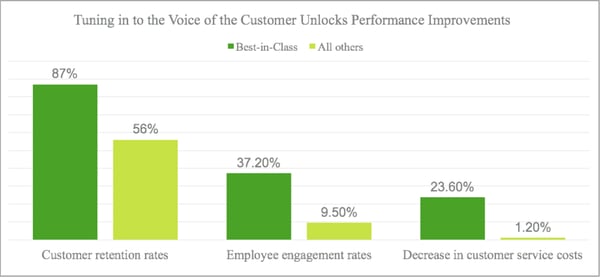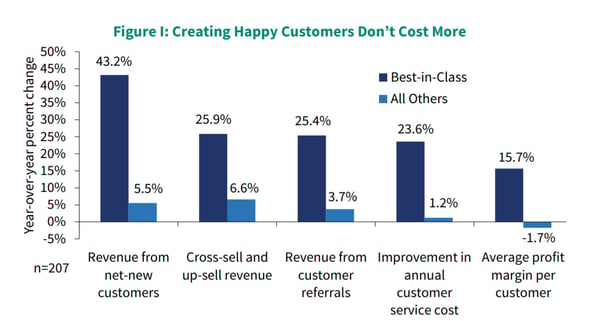October 6, 2020
 by Savan Kharod / October 6, 2020
by Savan Kharod / October 6, 2020

In the hyper-competitive world of business, your ability to retain customers can be the difference between success and failure.
So it’s vital that you keep your customers front of mind in everything you do. After all, if you’ve got happy customers, then more than likely, you’re going to have a happy business, too. But the secret to keeping your customers coming back isn’t a product or price – it’s about the customer experience you provide for them.
As many as 86% of consumers are even ready to pay more if it means a better customer experience. The question is, how do you ensure they get it? Well, all the information you need is right there in your customer feedback.
Think of customer feedback as your golden ticket, not only to an improved product or service, but to an enhanced customer experience, too. And that in turn means increased sales and revenue. Research reveals that collecting and using customer feedback can increase cross-selling and upselling success rates by 15-20%.

According to the same report, feedback can also help brands decrease the cost of customer retention. Businesses that actively use feedback data as part of their Voice of the Customer (VoC) programs ultimately spend 25% less on retaining customers in comparison to those that don’t.
Another survey by The Aberdeen Group discovered that brands who implemented a VoC program as part of their retention efforts generated a 10x greater yield in annual company revenue. However, if you want to achieve similar results for your business, you first need to know exactly what Voice of the Customer is, and the role customer feedback plays in it.
Voice of the Customer is an analytical method used to identify customers' desires and expectations. It collects everything customers say about a business, product, or service to provide an overall picture. Businesses invest in VoC to understand the difference between customer perceptions and their actual experience, using the information to help shape and refine their products and services.
The term, coined by John R. Hauser and Abbie Griffin, is described as follows: “VoC provides a detailed understanding of the customer’s requirements, a common language for the team going forward in the product development process, key input for the setting of appropriate design specifications for the new product or service, and a highly useful springboard for product innovation.”
As the definition above shows, VoC is based on two things:
Before examining how to gather feedback in more detail, let’s take a look at the actual process a VoC program entails.
Typically, it involves three stages:

While you can use a range of methods to try and improve customer experience, they usually fall under the scope of one of these three overarching themes – all of which contribute towards enhancing customer satisfaction and loyalty, and therefore referrals and sales, too. Gathering and scrupulously evaluating data in this way gives you a more objective view of your customers’ expectations, thus shedding light on the measures you need to take to improve their overall experience.
Forward-thinking brands making best use of VoC data have revolutionized not only their own market standing, but the overall business landscape as well. When brands truly know their customers' needs, they can make better choices and shape their processes accordingly – including anything from marketing and distribution to product creation and consumer success.
VoC data benefits both you and your customers – your customers through an improved experience, and your company through better performance. According to an Aberdeen Group survey, the top-ranking VoC providers recorded 55% higher customer retention rates, along with a 23% decline in customer service costs.
Capturing feedback from your customers doesn’t have to be difficult. Here are 11 easy ways
One effective way of acquiring VoC data is through on-site customer surveys. These surveys help you understand your customers and bring to light the types of problems they face. Always remember though – if you don’t ask the right questions, you won’t get the right answers. That's why pre-planning your surveys is so important.
To achieve the best results, make sure you:
Customer interviews are a traditional stalwart of VoC data collection. They are widely used to understand consumer perspectives on service issues, product attributes, and the general impression of a brand. Businesses can conduct such interviews for a single customer, or for entire groups of customers who share similar attributes. Although typically executed in person, they can be conducted over the phone if needed.
The behavior your customers exhibit on your website is a rich source of VoC data You can extract valuable information such as customer heat maps, scroll maps, and even eye-tracking, all in a matter of minutes – especially if you use a single platform that brings all of that functionality under one roof.
Social media is one of the best mediums for gathering VoC customer feedback. A potent tool in its own right, it provides the opportunity to connect and interact with your customers, creating a two-way communication channel.
According to a study by Microsoft, one third of Americans have used social media to complain about a brand or its customer service. Having a social media presence across platforms such as LinkedIn, Facebook, and Twitter, among others, therefore gives you a valuable insight into customer issues.
Going one step further, you can use social listening to conduct sentiment analysis and see exactly what users are saying about your brand, be that positive or negative, beyond the direct conversations they have with you. You can then use this data to improve your customer experience strategy.
Focus groups involve gathering your customers in a room and inviting them to express their opinions, thoughts, and feelings regarding your goods or services. The participants of the group are guided through a discussion by a moderator.
Focus groups are often used in addition to interviews and surveys to add more depth to Voice of the Customer data. Having multiple participants can often lead to lively discussion and allow ideas to spark off each other. The qualitative data produced helps with both product improvements and the development of marketing material.
Live chat is your customers’ new best friend. In fact, 44% of respondents prefer using live chat for online shopping questions. In addition to using live chat for customer support a live chat feature on your website lets you gather real-time feedback and follow-up surveys from customers right after an event, giving you the chance to rectify any issues immediately, thereby increasing customer satisfaction. This makes it a tremendously useful tool for capturing Voice of the Customer data.
Your approach to email can be as casual or formal as you like. You could send highly personalized emails to specific customer segments, or even build a template which can be used for the entire customer pool. There is always the option to seek further details for a particular answer as well, or to include a link to another one of your polls/surveys.
Did you know that 86% of visitors are hesitant to purchase from companies that have negative reviews online? Your online credibility is not just a product of what you create yourself – it also includes any other references to your brand online, particularly online reviews. Exploring positive and negative reviews, and the sentiment behind them, can be especially helpful in revealing issues customers may not wish to share with you directly.
If you're considering leveraging any historical data you might have, call recordings are a good option. Recorded calls with customers provide you with an overview of how your brand is seen, the kind of complaints your customers have about your products or services, and, perhaps most importantly of all, what they expect from your brand.
Although it can be a labor-intensive process, it does offer rich data rewards. You can also use these recordings to learn how your customer-facing and support staff are performing and discover areas where further training may be required.
As most of your customers will keep their smartphone on them at all times, SMS messages are a great way to reach out to them no matter where there might be. Incorporating SMS into your VoC program also makes it incredibly convenient for customers to complete your surveys, helping to increase the likelihood of a response.
Net Promoter Score (NPS) is a strategic metric you can use to evaluate customer engagement. It measures customer loyalty by asking one simple question: "How likely are you to recommend our company to a friend or a colleague?"
Answers are provided on a scale of 1-10 and segmented into three groups:
Review these best practices to ensure your VoC program is providing the most value for your company’s needs.
The success of your VoC Program is heavily dependent on the use of high quality tools and services. To ensure you gather the insights you need, be prepared to invest in software that makes data collection and analysis more effective. Customer service, marketing, and analytics platforms help you visualize data, streamline processes, discover new insights, and collaborate across teams and departments.
Omni-channel feedback software helps you go one step further, aggregating feedback from all channels to highlight customer behavior, preferences, and satisfaction levels on an enterprise-wide scale. These insights in turn help you create a more seamless customer experience.
Feedback isn’t much use to you unless you act on it. And customers want to see evidence that their opinions are being listened to and taken seriously. Building an efficient VoC program requires not only the right data, but collaboration across multiple departments to make best use of it, too.
All relevant departments should have a say in collecting and analyzing data, as well as creating action plans based on the insights the data provides. Make sure you have the necessary communication tools and support for your employees to work together and connect across teams and divisions.
No picture of what’s going on in your company is truly complete without a view of your employees’ opinions, too. Collecting employee feedback does two things in particular to improve the customer experience.
Namely, it:
A proper VoC tool should help everyone at your company understand what’s going on – and do that in the context that makes most sense to them. So, invest in a platform that lets you customize dashboard views for particular positions within your company and provides the right insights for the right personnel. Take care to loop in the appropriate people, all the way from the management team to the frontline staff.
Any program aimed at improving customer experience has to prove it delivers value to your business. That’s why you need to orient your VoC programme towards ROI, and place ROI as the end goal of any changes you make. To successfully measure VoC ROI, you’re going to need to know the cost of your VoC program, as well as the financial implications of any improvement to associated metrics it generates, such as NPS. From there you can see if the costs exceed the benefits, and whether your VoC efforts are viable or not.
Here are two company examples of brands utilizing the Voice of the Customer to the best of their ability.
Convertize used customer feedback to help refine newly-released product features. The feedback gathered from the VoC program offered an invaluable insight into usage of their platform. Leveraging these insights, Convertize revamped its notifications feature and launched two separate options for where notifications could appear on a website.
When a user expressed dissatisfaction over certain aspects of the feature after its launch, Convertize listened, determined to understand what the issue was. Based on that feedback, Convertize made the necessary changes and released the fix within two weeks.
According to Musa Hanhan, Head of Customer Experience Design at Genesys, their voice of the customer program was the lynchpin of their newfound success. Explaining how it helped revolutionize customer services, he said: “Our established VoC practice is transformative both internally for us and for our customers.”
As part of their VoC program, Genesys customers were asked to participate in surveys or feedback interviews. As soon as they saw their preferences reflected in the end product, they understood that their voice mattered to the company.
Continuing where he left off, Hanhan explained, “It’s transformative because it has changed the way we think as we are able to see through the lens of our customer thanks to their direct feedback. Plus, it has helped our employees to engage with our customers better. Finally, it has impacted the way we create services for our customers.”
Understanding your customers’ expectations and desires is key to the success of your business. Don't ever just assume you know what they are, though; make sure you go out and ask your customers directly. After all, who could know what your customers want better than the customers themselves?
But if you really want to deliver the best possible experience and stay competitive in the market, you have to go one step further than listening to what your customers have to say. You have to act on it, too. And the best mechanism for doing that? A well-designed VoC program.
Savan Kharod is a Digital Marketing professional at Acquire. He loves to share his knowledge and experience in digital marketing, social media marketing, customer service and growth marketing. In his free time, Savan likes to backpack and explore new places.
Even as a newly minted organization, UpContent knew that the customer voice is a critical...
 by Erin Boyd
by Erin Boyd
Today’s buying process is more about creating relationships than transactions, and like any...
 by Cristina Maria
by Cristina Maria
First impressions matter.
 by Mohammad Farooq
by Mohammad Farooq
Even as a newly minted organization, UpContent knew that the customer voice is a critical...
 by Erin Boyd
by Erin Boyd
Today’s buying process is more about creating relationships than transactions, and like any...
 by Cristina Maria
by Cristina Maria


